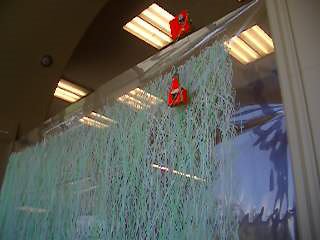Art or Invention?
Last weekend I went to Maker Faire 2006, a faire hosted by Make Magazine. How can I describe this event? It was a cross between a Science Fair, a carnival, and Burning Man (well my impression of Burning Man—I've never been there). For a weekend, inventors came out of their garages to showcase their creations for the public. It gave me the feeling that time had become twisted causing the Renaissance to collide with the Digital Age. It was a lot of fun. I highly recommend checking it out next year if you're in the Silicon Valley.
I went to Make 2006 to understand something about creativity I still couldn't quite figure out. I think most people would agree that both artists and inventors have creativity. But invention is about creating something useful, something that solves a problem. Are artists also trying to solve some kind of problem or is art (A) equivalent to invention (I) minus function (F)?
A = I - F (Equation 1)
I asked several inventors about their motives for inventing. In particular, I wanted to talk to inventors who had created something seemingly functionless. If I looked at their invention and I said to myself, "now what's the point of that?" then that was an inventor I wanted to understand better. Here is what I learned from three of them.
The first was a musician, pictured below, I don't remember his name (my apologies). A crowd swarmed around him. I peaked over their shoulders to see the mad-scientist/artist below gesticulating wildly. With each flick of his fingers, a new sound emerged which created the most wonderful music. But why?

I asked him why he made his musical glove and he explained to me that when he was getting started as a musician, people would hire him to produce electronic music for parties. He didn't like sitting behind a laptop though, he wanted to get up and entertain the audience with more than his music. So he created a special glove that gave him the same control as his computer but allowed him to get up and perform. I once heard that a similar thing happened with drummers in rock bands when the electric guitarists started claiming center stage. Drummers started putting a lot more flare into playing their instrument. So there you go, an artist with a specific problem that motivated him to innovate artistically.
But I was still skeptical. I thought when I found the Giant Painting Machine below, I had found an instance of art unadulterated by the economic, social, and political motivations that seem to drive invention. Stretching up before me was an enormous painting consisting of nothing but squiggly lines in varying shades of green. It was still being painted, in fact, by none other than a painting robot. Surely this had to be a functionless, purely artistic creation, right?

Wrong. When I spoke to the artist, Douglas Irving Repetto, I found out there was a very practical explanation for the art and the invention for creating it. One of his patrons had asked him to fill a big blank wall. Finding he needed to do a lot of repetitive work to create a giant painting, he did what human beings have done since at least the time that farming replaced hunting, he looked for a way to get more output with less work. He built a machine to paint for him.
It's a neat invention consisting of a motorized brush holder attached to a 2-axis pulley system. I didn't see if the artist controlled it by remote control, but I can just picture him reclining in a Lazy Boy, RC in one fist, ice tea in the other painting away at an enormous canvas.
My hypothesis was not holding up so far, but when I saw what's pictured below, I thought for sure I'd found a purely functionless invention that couldn't be called much more than modern art. It was the world's biggest iPod.

This was it, I thought: a purposeless invention, a perfect example of wasted human creativity. Why would someone turn something that's main benefit is its small size and make it huge? It was just to be "creative," right? It couldn't possibly have a function...or could it?
I had been foiled twice by my incomplete world view so I wasn't going to let it happen again. Smart thing I held back my urge to ridicule this so-called invention, because it turned out there was a perfectly reasonable explanation for the device. The creator had a collection of vinyl records he wanted to be able to listen to on his iPod. So he bought an old fashioned record player and rewired it so he could control it with his iPod, thus allowing him to convert the songs to electronic form. The artistic irony was secondary, the need was the primary driver. So there you go, another piece of art that's actually an invention.
Does pure art, unadulterated by the needs of human beings even exist? Are invention and art independent concepts that both happen to be driven by creativity? Or is art a type of invention? I'd appreciate your help in understanding this issue that has perplexed me for years. Maybe you can explain the bicycle below made out of a 2 by 4 and a single wheel. Is that art or an invention? I didn't get a chance to ask its creator what the motivation was, but from my experience talking to the musicians and painter above I guess I should expect to be surprised that there was a functional reason to invent this enigmacycle.

I went to Make 2006 to understand something about creativity I still couldn't quite figure out. I think most people would agree that both artists and inventors have creativity. But invention is about creating something useful, something that solves a problem. Are artists also trying to solve some kind of problem or is art (A) equivalent to invention (I) minus function (F)?
A = I - F (Equation 1)
I asked several inventors about their motives for inventing. In particular, I wanted to talk to inventors who had created something seemingly functionless. If I looked at their invention and I said to myself, "now what's the point of that?" then that was an inventor I wanted to understand better. Here is what I learned from three of them.
The first was a musician, pictured below, I don't remember his name (my apologies). A crowd swarmed around him. I peaked over their shoulders to see the mad-scientist/artist below gesticulating wildly. With each flick of his fingers, a new sound emerged which created the most wonderful music. But why?

I asked him why he made his musical glove and he explained to me that when he was getting started as a musician, people would hire him to produce electronic music for parties. He didn't like sitting behind a laptop though, he wanted to get up and entertain the audience with more than his music. So he created a special glove that gave him the same control as his computer but allowed him to get up and perform. I once heard that a similar thing happened with drummers in rock bands when the electric guitarists started claiming center stage. Drummers started putting a lot more flare into playing their instrument. So there you go, an artist with a specific problem that motivated him to innovate artistically.
But I was still skeptical. I thought when I found the Giant Painting Machine below, I had found an instance of art unadulterated by the economic, social, and political motivations that seem to drive invention. Stretching up before me was an enormous painting consisting of nothing but squiggly lines in varying shades of green. It was still being painted, in fact, by none other than a painting robot. Surely this had to be a functionless, purely artistic creation, right?

Wrong. When I spoke to the artist, Douglas Irving Repetto, I found out there was a very practical explanation for the art and the invention for creating it. One of his patrons had asked him to fill a big blank wall. Finding he needed to do a lot of repetitive work to create a giant painting, he did what human beings have done since at least the time that farming replaced hunting, he looked for a way to get more output with less work. He built a machine to paint for him.
It's a neat invention consisting of a motorized brush holder attached to a 2-axis pulley system. I didn't see if the artist controlled it by remote control, but I can just picture him reclining in a Lazy Boy, RC in one fist, ice tea in the other painting away at an enormous canvas.
My hypothesis was not holding up so far, but when I saw what's pictured below, I thought for sure I'd found a purely functionless invention that couldn't be called much more than modern art. It was the world's biggest iPod.

This was it, I thought: a purposeless invention, a perfect example of wasted human creativity. Why would someone turn something that's main benefit is its small size and make it huge? It was just to be "creative," right? It couldn't possibly have a function...or could it?
I had been foiled twice by my incomplete world view so I wasn't going to let it happen again. Smart thing I held back my urge to ridicule this so-called invention, because it turned out there was a perfectly reasonable explanation for the device. The creator had a collection of vinyl records he wanted to be able to listen to on his iPod. So he bought an old fashioned record player and rewired it so he could control it with his iPod, thus allowing him to convert the songs to electronic form. The artistic irony was secondary, the need was the primary driver. So there you go, another piece of art that's actually an invention.
Does pure art, unadulterated by the needs of human beings even exist? Are invention and art independent concepts that both happen to be driven by creativity? Or is art a type of invention? I'd appreciate your help in understanding this issue that has perplexed me for years. Maybe you can explain the bicycle below made out of a 2 by 4 and a single wheel. Is that art or an invention? I didn't get a chance to ask its creator what the motivation was, but from my experience talking to the musicians and painter above I guess I should expect to be surprised that there was a functional reason to invent this enigmacycle.


